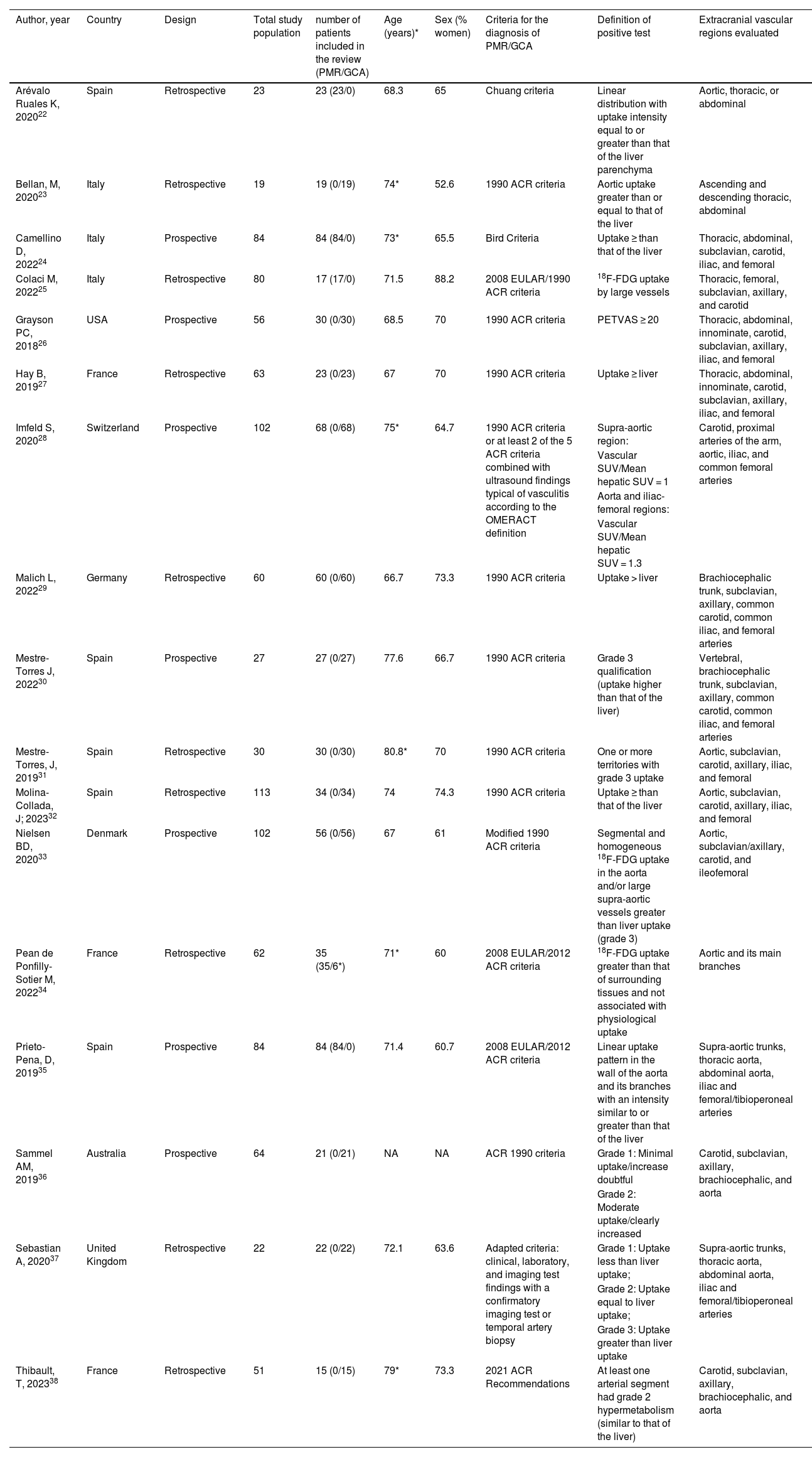Systematic review of current evidence to analyze the prevalence of extracranial large vessel vasculitis (LVV) using 18F-FDG PET/CT in patients with polymyalgia rheumatica (PMR) or giant cell arteritis (GCA).
Materials and methodsPubMed and EMBASE were searched and the results were screened by two reviewers. Study quality was assessed using a modified version of the Newcastle-Ottawa scale. Heterogeneity between studies was assessed using the I2 statistic and the Q test. Further subgroup analyses were performed by disease type, study quality, and 18F-FDG PET/CT uptake criteria. Publication bias was assessed by funnel plot and Egger's test.
Results268 publications were identified, of which 17 met the selection criteria and were included in the meta-analysis. The overall pooled prevalence of extracranial LVV by 18F-FDG PET/CT was 54.5% [95% CI: 42.6%–66.1%]. In patients with GCA the prevalence was significantly higher than in patients with PMR (60.1% vs. 41.8%, P = 0.006). Likewise, studies with a lower risk of bias reported a higher prevalence of extracranial LVV (61.1% vs. 46.9%; P = 0.010). No publication bias was observed.
ConclusionsThe 18F-FDG PET/CT test may be useful in the detection of extracranial LVV, both in patients with PMR or GCA. Such involvement is more frequent in patients with GCA, and may vary depending on the quality of the studies.
Revisión sistemática de la evidencia actual para analizar la prevalencia de vasculitis de gran vaso (VGV) extracraneal detectada mediante 18F-FDG PET/TC en pacientes con polimialgia reumática (PMR) o arteritis de células grandes (ACG).
Material y métodosSe realizaron búsquedas en PubMed y EMBASE en febrero de 2023, y los resultados fueron examinados por dos revisores. La calidad de los estudios fue evaluada con la escala Newcastle-Ottawa modificada. La heterogeneidad se evaluó mediante I2 y la prueba Q. Se utilizó el modelo de efectos aleatorios en presencia de heterogeneidad relevante. Se realizó un análisis de subgrupos comparando los resultados por tipo de enfermedad, calidad de los estudios y criterio de captación. El sesgo de publicación fue evaluado mediante el gráfico de embudo (funnel plot) y la prueba de Egger.
ResultadosSe identificaron 268 publicaciones, de las cuales 17 cumplieron los criterios de selección y fueron incluidas en el metaanálisis. La prevalencia combinada total de VGV extracraneal por18F-FDG PET/TC fue de 54,5% [IC 95%: 42,6% a 66,1%]. En ACG la prevalencia fue significativamente más elevada que en PMR (60,1% vs. 41,8%, P = 0,006). A su vez, los estudios con menor riesgo de sesgo presentaron mayor prevalencia de VGV extracraneal (61,1% vs. 46,9%; P = 0,010). No se observó sesgo de publicación.
ConclusionesEl estudio con 18F-FDG PET/TC puede ser útil en la detección de VGV extracraneal, tanto en pacientes con PMR como con ACG. Dicha afectación es más frecuente en ACG, y puede variar en función de la calidad de los estudios.
Article
Diríjase desde aquí a la web de la >>>FESEMI<<< e inicie sesión mediante el formulario que se encuentra en la barra superior, pulsando sobre el candado.

Una vez autentificado, en la misma web de FESEMI, en el menú superior, elija la opción deseada.

>>>FESEMI<<<











